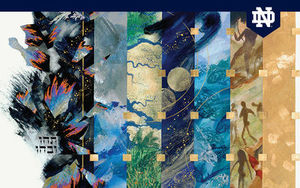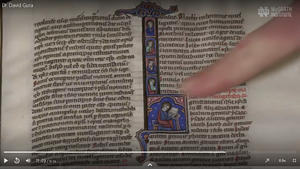Medieval Bible Features Prominently in McGrath Institute MOOC
Beginning Ash Wednesday, February 26, and continuing until Pentecost Sunday, May 31, the McGrath Institute for Church Life at the University of Notre Dame is hosting a Massive Online Open Course (MOOC) titled Journey with the St. John's Bible. The course is divided into six units and is taught by instructors from Notre Dame’s Theology department, the Program of Liberal Studies, and the McGrath Institute, as well as The Hesburgh Library’s Rare Books & Special Collections.
The St. John's Bible is a completely handwritten and illuminated Bible commission by the Benedictine St. John's Abbey in Collegeville, Minnesota. First commissioned in 1998, the St. John's Bible was completed in December 2011. Led by Donald Jackson, official scribe and calligrapher to the Crown Office of United Kingdom of Great Britain and Northern Ireland, the team that produced the Bible included experts in English and Hebrew calligraphy as well as illumination, sculpture, theology, and manuscript studies.

Because the St. John's Bible used traditional medieval methods of calligraphy and illumination, the McGrath Institute MOOC includes several modules on the medieval Bible, focusing on both the theological and practical aspects of the Bible as a material object. One of these modules, "The Medieval Bible," is being taught by MI Faculty Fellow Dr. David Gura. Dr. Gura is Curator of Ancient and Medieval Manuscripts at the Hesburgh Library as well as Concurrent Associate Professor at the Medieval Institute. As an expert in medieval paleography and codicology, Dr. Gura discussed aspects of medieval book production and the evolution of the Bible as a physical object.
Reflecting on his experience creating this module, Dr. Gura remarked, "It was a wonderful experience to work with McGrath Institute for Church Life on this module, and I thank them for their diligence and professionalism during the production. This section of the course was a great deal of fun, especially to bring our medieval manuscript collection to a wider audience in both academic and pastoral contexts."
Dr. Gura's teaching was aided by the Hesburgh Library's robust collection of medieval manuscripts. As Dr. Gura notes, "The Hesburgh Library's collection of medieval Bibles and fragments enabled me to discuss the various formats of the Bible (e.g., glossed, pandect, Atlantic, etc.) during the Middle Ages using actual manuscripts—something that ties in so well with the Saint John's Bible experience. Above all, the Ferrell Bible (a fully historiated 13th-century Parisian Bible) is the collection's most illustrative specimen and it was a privilege to share it with the larger community." The Ferrell Bible is named after its donors to the Hesburgh Library.

Although the St. John's Bible is a modern work, it was produced using techniques from the Middle Ages. By offering a MOOC dedicated to the St. John's Bible, the McGrath Institute has helped make this important aspect of medieval history available to a broader public.